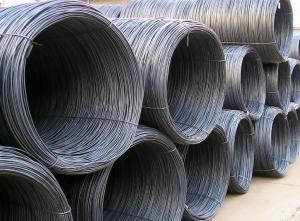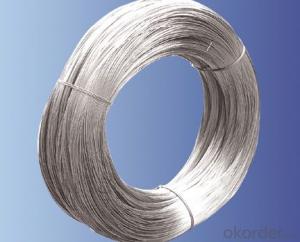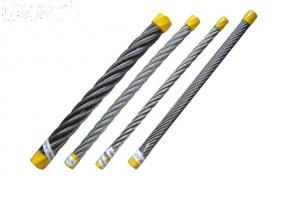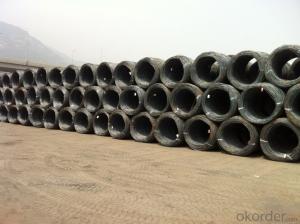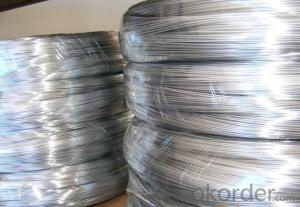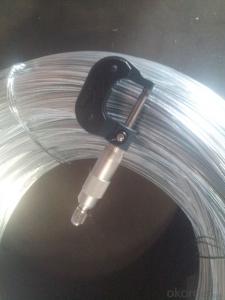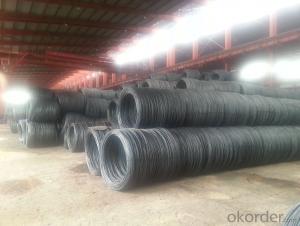Wire Rod
- Loading Port:
- China Main Port
- Payment Terms:
- TT OR LC
- Min Order Qty:
- -
- Supply Capability:
- 10000 m.t./month
OKorder Service Pledge
OKorder Financial Service
You Might Also Like
Product Description:
Specifications of Hot Rolled Wire Rod:
Steel Grade: Q195/235, SAE1006-1018B Standard: ASTM, GB
Diameter: 5.5mm, 6.5mm, 7mm,8mm,9mm,10mm,12mm,14mm
Type: in coil, coil weight around 2MT Alloy or Not: Alloy
Technique: Hot Rolled Place of Origin: China Mainland
Surface: round, no twisted, light and smooth Brand Name: HSKY
Chemical Composition: (Please kindly find our chemistry of our material based on Q195、Q235A and Q235B as below for your information)
| Trademark | Rank | Chemical composition (quality score) % | ||||
| C | Si | Mn | S | P | ||
| | ||||||
| ≤ | ≤ | ≤ | ||||
| Q195 | 0.06-0.12 | 0.30 | 0.25 | 0.050 | 0.045 | |
| Q235 | A | 0.14-0.22 | 0.30 | 0.30-0.65 | 0.050 | 0.045 |
| Q235 | B | 0.12-0.20 | 0.30 | 0.30-0.70 | 0.045 | 0.045 |
Usage and Applications of Hot Rolled Wire Rod:
After hot-rolled the products shaped into coil and delivery as finished product, including round, square, rectangular, hexagonal and so on. Since most of the products are round, it is generally called wire rod. Carbon steel wire rod is widely used in construction and manufacturing. Carbon steel wire rod is mainly used for reinforcement of reinforced concrete and welded structure or reprocessed (roberts , nail, etc.) materials, especially used to produce wire drawing, welding electrode, nails, spring, electronic, precise machinery parts and so on.
Packaging & Delivery of Hot Rolled Wire Rod:
Packaging Detail: products are packed in coil, each coil weight around 2 MT, and then shipped by container or bulk vessel
Delivery Detail: within 45 days after received deposit or LC.
Label: to be specified by customer, generally, each bundle has 1-2 labels
Trade terms: FOB, CFR, CIF
- Q: How is the bending properties of steel wire rod tested?
- The bending properties of steel wire rod can be tested by subjecting it to a bending test, where the rod is bent to a specified angle and checked for any signs of cracking, deformation, or failure. This test helps determine the flexibility and strength of the wire rod under bending forces.
- Q: How is the surface roughness of steel wire rod controlled during manufacturing?
- The surface roughness of steel wire rods is controlled during manufacturing through various processes and techniques. One of the primary methods used is the selection of appropriate raw materials. High-quality steel with a specific chemical composition and controlled impurities is chosen to ensure a smoother surface finish. During the manufacturing process, the wire rod undergoes several mechanical treatments to achieve the desired surface roughness. These treatments include hot rolling, cold drawing, and heat treatment. Hot rolling is the initial step where the steel is heated and passed through a series of rolling mills. This process helps in reducing the surface roughness by eliminating surface defects and improving the overall surface finish. Cold drawing is another crucial step that involves pulling the wire rod through a series of dies at room temperature. This process further refines the surface finish and reduces the roughness by removing any residual scale or imperfections. Heat treatment is often employed after the cold drawing process to enhance the mechanical properties of the wire rod. It involves controlled heating and cooling cycles, which can also help in improving the surface finish by reducing any remaining surface irregularities. Additionally, surface treatments such as pickling, shot blasting, or chemical cleaning may be employed to remove any remaining oxide layers or contaminants on the surface of the wire rod. These treatments further reduce the surface roughness and enhance the overall appearance of the product. Regular quality control inspections and measurements are conducted during the manufacturing process to ensure that the desired surface roughness specifications are met. These inspections may include visual inspections, dimensional measurements, and surface roughness testing using instruments such as profilometers. In summary, the surface roughness of steel wire rods is controlled during manufacturing through careful selection of raw materials, mechanical treatments like hot rolling and cold drawing, heat treatment, surface treatments, and rigorous quality control measures. These techniques ensure that the final wire rod product has a smooth surface finish and meets the required specifications.
- Q: How is steel wire rod used in the manufacturing of wire rope decking?
- Steel wire rod is used in the manufacturing of wire rope decking as it serves as the raw material for creating the individual wires that are twisted and braided together to form the rope. The steel wire rod is drawn through a series of dies to reduce its diameter and increase its strength, resulting in high-quality wires that are then woven into the wire rope decking, providing strength, durability, and load-bearing capacity.
- Q: How is steel wire rod used in the manufacturing of wire forms for automotive exhaust systems?
- Steel wire rod is a crucial component in the manufacturing of wire forms for automotive exhaust systems. These wire forms are used to provide structural support and stability to the exhaust system, ensuring its proper functioning and longevity. Firstly, steel wire rod is used to create the main framework of the wire form, which serves as the backbone of the exhaust system. This framework is responsible for holding and positioning various components of the exhaust system, such as the muffler, catalytic converter, and pipes. The high tensile strength and durability of steel wire rod make it an ideal choice for this application, as it can withstand the intense vibrations, heat, and pressure that the exhaust system is subjected to. Additionally, steel wire rod is used to form the hangers and brackets that secure the exhaust system to the vehicle's chassis. These hangers and brackets are essential for maintaining the proper alignment and stability of the exhaust system, preventing any unnecessary movement or rattling. The flexibility and malleability of steel wire rod allow it to be easily shaped and formed into the desired hanger or bracket design, ensuring a precise fit and reliable performance. Furthermore, steel wire rod is also utilized in the fabrication of wire mesh screens and filters that are installed within the exhaust system. These screens and filters are responsible for trapping and removing contaminants, such as particulate matter and harmful gases, from the exhaust gases before they are released into the environment. The high strength and corrosion resistance of steel wire rod make it an excellent choice for constructing these screens and filters, as they need to withstand the harsh operating conditions and exposure to corrosive elements. In summary, steel wire rod plays a crucial role in the manufacturing of wire forms for automotive exhaust systems. Its high tensile strength, durability, flexibility, and corrosion resistance make it an ideal material for creating the main framework, hangers, brackets, and screens/filters within the exhaust system. By using steel wire rod, manufacturers can ensure that the wire forms provide the necessary structural support, stability, and reliability required for proper functioning of the automotive exhaust system.
- Q: What are the common production processes for low carbon steel wire rod?
- The common production processes for low carbon steel wire rod include melting and refining the raw materials, continuous casting to form billets, hot rolling the billets into wire rod coils, cooling and coiling the wire rod, and finally, surface treatment and packaging for shipment.
- Q: How are steel wire rods used in the production of piano wire?
- Steel wire rods are used in the production of piano wire by being drawn through a series of dies to gradually reduce their diameter. This process, known as wire drawing, results in a long, thin, and high-tensile strength wire that is then coiled, hardened, and tempered to create the strong and resilient piano wire used in piano strings.
- Q: What are the different types of steel wire rod processing equipment?
- In the manufacturing and production process, various types of steel wire rod processing equipment are utilized. These equipment have been designed to carry out different tasks and processes, with the aim of converting raw steel wire rods into finished products. Among the diverse range of steel wire rod processing equipment are the following: 1. Wire Drawing Machines: These machines function by pulling the wire rod through a series of dies, resulting in a reduction in diameter. This process enhances the wire's surface finish, accuracy, and strength. 2. Wire Straightening and Cutting Machines: These machines are utilized to straighten and cut the wire rod into desired lengths. They are capable of handling different wire diameters and are commonly employed in the production of wire products such as nails, screws, and wire mesh. 3. Wire Annealing Furnaces: For the purpose of softening the wire rod and improving its ductility and machinability, annealing is employed as a heat treatment process. Annealing furnaces provide controlled heating and cooling conditions, facilitating the attainment of the desired properties. 4. Wire Coiling Machines: These machines are responsible for winding the straightened and cut wire rod into coils. Depending on the volume and size of the coils required, they can be either manual or automated. 5. Wire Galvanizing Lines: In order to protect the wire rod from corrosion, a layer of zinc is applied to its surface through the process of galvanizing. Galvanizing lines are employed to clean, flux, and coat the wire rod with molten zinc. 6. Wire Electroplating Equipment: Electroplating is a technique employed to deposit a thin layer of metal onto the surface of the wire rod, with the purpose of enhancing its appearance or providing specific properties. Electroplating equipment encompasses tanks, rectifiers, and various chemical solutions. 7. Wire Mesh Welding Machines: These machines are utilized to weld the wire rods together, creating wire mesh products such as fences, reinforcement grids, and filter screens. The level of automation varies depending on the complexity of the mesh design. 8. Wire Stranding Machines: In the production of electrical cables and conductors, stranding machines are employed to twist multiple wire rods together, resulting in stranded cables. In conclusion, the diverse range of steel wire rod processing equipment plays a critical role in the manufacturing and production of various wire and steel products. These machines enable the conversion of raw materials into finished products that possess the desired properties and meet the required specifications.
- Q: What are the common production processes for radium-coated steel wire rod?
- The common production processes for radium-coated steel wire rod typically involve several steps. First, the steel wire rod is cleaned and prepared to ensure its surface is free from any impurities. Then, a layer of radium coating is applied to the wire rod through a process called electroplating or electroless plating. This involves immersing the wire rod in a solution containing radium ions and applying an electric current or using a chemical reaction to deposit the radium onto the surface of the wire rod. After the coating process, the radium-coated wire rod is typically inspected for quality and undergoes any necessary finishing processes, such as cutting, shaping, or heat treatment, depending on its intended application.
- Q: What are the standard impact strength requirements for steel wire rod?
- The standard impact strength requirements for steel wire rod vary depending on the specific application and industry standards. However, in general, steel wire rods are expected to possess a high level of impact strength to withstand various loading conditions and prevent failure or deformation. These requirements typically include meeting specific impact energy values, as specified by relevant industry standards or customer specifications.
Send your message to us
Wire Rod
- Loading Port:
- China Main Port
- Payment Terms:
- TT OR LC
- Min Order Qty:
- -
- Supply Capability:
- 10000 m.t./month
OKorder Service Pledge
OKorder Financial Service
Similar products
Hot products
Hot Searches
Related keywords


